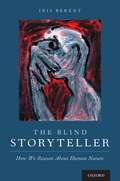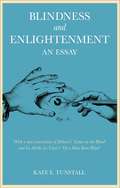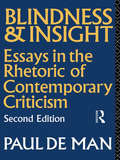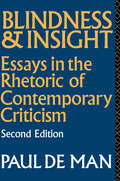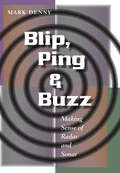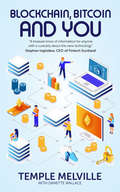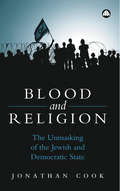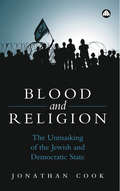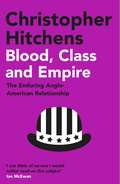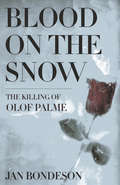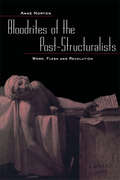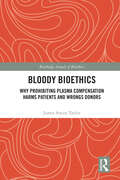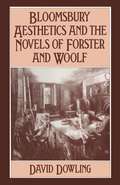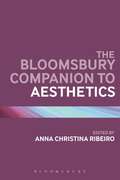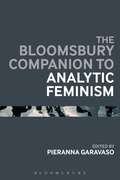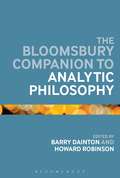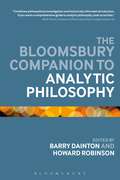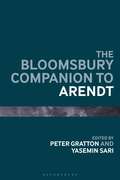- Table View
- List View
The Blind Storyteller: How We Reason About Human Nature
by Iris BerentDo newborns think? Do they know that "three" is greater than "two"? Do they prefer "right" to "wrong"? What about emotions--can newborns recognize happiness or anger? If the answer to these questions is yes, then how are our inborn thoughts and feelings encoded in our bodies? Could they persist after we die? Going all the way back to ancient Greece, human nature and the mind-body problem have been the topics of fierce scholarly debates. But laypeople also have strong opinions about such matters. Most people believe, for example, that newborn babies don't know the difference between right and wrong--such knowledge, they insist, can only be learned. For emotions, they presume the opposite--that our capacity to feel fear, for example, is both inborn and embodied. These beliefs are stories we tell ourselves about what we know and who we are. They reflect and influence our understanding of ourselves and others and they guide every aspect of our lives. In The Blind Storyteller, the cognitive psychologist Iris Berent exposes a chasm between our intuitive understanding of human nature and the conclusions emerging from science. Her conclusions show that many of our stories are misguided. Just like Homer, we, the storyteller, are blind. How could we get it so wrong? In a twist that could have come out of a Greek tragedy, Berent proposes that our errors are our fate. These mistakes emanate from the very principles that make our minds tick: Our blindness to human nature is rooted in human nature itself. An intellectual journey that draws on philosophy, anthropology, linguistics, cognitive science, and Berent's own cutting-edge research, The Blind Storyteller grapples with a host of provocative questions, from why we are so afraid of zombies, to whether dyslexia is "just in our heads," from what happens to us when we die, to why we are so infatuated with our brains. The end result is a startling new perspective on the age-old nature/nurture debate--and on what it means to be human.
Blindness and Enlightenment: With a new translation of Diderot's 'Letter on the Blind' and La Mothe Le Vayer's 'Of a Man Born Blind'
by Kate E. TunstallBlindness and Enlightenment presents a reading and a new translation of Diderot's Letter on the Blind. Diderot was the editor of the Encyclopédie, that Trojan horse of Enlightenment ideas, as well as a novelist, playwright, art critic and philosopher. His Letter on the Blind of 1749 is essential reading for anyone interested in Enlightenment philosophy or eighteenth-century literature because it contradicts a central assumption of Western literature and philosophy, and of the Enlightenment in particular, namely that moral and philosophical insight is dependent on seeing. Kate Tunstall's essay guides the reader through the Letter, its anecdotes, ideas and its conversational mode of presenting them, and it situates the Letter in relation both to the Encyclopedie and to a rich tradition of writing about and, most importantly, talking and listening to the blind.
Blindness and Enlightenment: With a new translation of Diderot's 'Letter on the Blind' and La Mothe Le Vayer's 'Of a Man Born Blind'
by Kate E. TunstallBlindness and Enlightenment presents a reading and a new translation of Diderot's Letter on the Blind. Diderot was the editor of the Encyclopédie, that Trojan horse of Enlightenment ideas, as well as a novelist, playwright, art critic and philosopher. His Letter on the Blind of 1749 is essential reading for anyone interested in Enlightenment philosophy or eighteenth-century literature because it contradicts a central assumption of Western literature and philosophy, and of the Enlightenment in particular, namely that moral and philosophical insight is dependent on seeing. Kate Tunstall's essay guides the reader through the Letter, its anecdotes, ideas and its conversational mode of presenting them, and it situates the Letter in relation both to the Encyclopedie and to a rich tradition of writing about and, most importantly, talking and listening to the blind.
Blindness and Insight: Essays in the Rhetoric of Contemporary Criticism
by Paul De ManFirst published in 1983. Routledge is an imprint of Taylor & Francis, an informa company.
Blindness and Insight: Essays in the Rhetoric of Contemporary Criticism
by Paul De ManFirst published in 1983. Routledge is an imprint of Taylor & Francis, an informa company.
Blip, Ping, and Buzz: Making Sense of Radar and Sonar
by Mark DennyHave you ever wondered how stealth planes achieve "invisibility," how sunken ships are found, or how fishermen track schools of fish in vast expanses of ocean? Radar and sonar echolocation—a simple matter of sending, receiving, and processing signals.Weaving history with simple science, Mark Denny deftly reveals the world of radar and sonar to the curious reader, technology buff, and expert alike. He begins with an early history of the Chain Home radar system used during World War II and then provides accessible and engaging explanations of the physics that make signal processing possible. Basic diagrams and formulas show how electromagnetic and sound waves are transmitted, received, and converted into images, allowing you to literally see in the dark.A section on bioacoustic echolocation, with a focus on the superior sonar systems of bats and whales and a discussion of the advanced technology of next-generation airborne signal processors, opens the imagination to fascinating possibilities for the future.
Blockchain, Bitcoin and You
by Temple MelvilleBlockchain and Bitcoin have become household names. BLOCKCHAIN, BITCOIN AND YOU explains the technical concepts that make up the blockchain and what they mean for the future of personal finance, as well as their role in business-relevant applications. Scotcoin’s CEO Temple Melville lifts the complex key principles of blockchain technology out of the preserve of academia and tech and delivers it to a new audience ― the people. Find out what the blockchain is; why it is needed and the problems it solves; why there is so much excitement about the blockchain and its potential; major components and their purpose; major application scenarios ― and what it means for you. “This book is a treasure trove of information for anyone with a curiosity about this new technology and what it means for them in their day to day lives, it helpfully explains the intricacies of blockchain technology in a refreshingly user-friendly and entertaining way.” Stephen Ingledew, Chief Executive of Fintech Scotland
Blood and Religion: The Unmasking of the Jewish and Democratic State
by Jonathan CookThis is an account of the Jewish state's motives behind building the West Bank wall, arguing that at the heart of the issue is demography. Israel fears the moment when the region’s Palestinians become a majority.*BR**BR*The book charts Israel’s increasingly desperate responses to its predicament including military repression of Palestinian dissent on both sides of the Green Line; accusations that Israel's Palestinian citizens and the Palestinian Authority are secretly conspiring to subvert the Jewish state from within; a ban on marriages between Israel’s Palestinian population and Palestinians living under occupation to prevent a right of return ‘through the back door’; the redrawing of the Green Line to create an expanded, fortress state where only Jewish blood and Jewish religion count.
Blood and Religion: The Unmasking of the Jewish and Democratic State
by Jonathan CookThis is an account of the Jewish state's motives behind building the West Bank wall, arguing that at the heart of the issue is demography. Israel fears the moment when the region’s Palestinians become a majority.*BR**BR*The book charts Israel’s increasingly desperate responses to its predicament including military repression of Palestinian dissent on both sides of the Green Line; accusations that Israel's Palestinian citizens and the Palestinian Authority are secretly conspiring to subvert the Jewish state from within; a ban on marriages between Israel’s Palestinian population and Palestinians living under occupation to prevent a right of return ‘through the back door’; the redrawing of the Green Line to create an expanded, fortress state where only Jewish blood and Jewish religion count.
Blood, Class and Empire: The Enduring Anglo-American Relationship (Nation Bks.)
by Christopher HitchensChristopher Hitchens' iconclastic collection is the perfect companion to US-UK relations by the greatest Anglo-American writer of his generation.Since the end of the Cold War so-called experts have been predicting the eclipse of America's "special relationship" with Britain. But as events have shown, especially in the wake of 9/11, the political and cultural ties between America and Britain have grown stronger. Blood, Class and Empire examines the dynamics of this relationship, its many cultural manifestations-the James Bond series, PBS "Brit Kitsch," Rudyard Kipling-and explains why it still persists. Contrarian, essayist and polemicist, Christopher Hitchens notes that while the relationship is usually presented as a matter of tradition, manners, and common culture, sanctified by wartime alliance, the special ingredient is empire; transmitted from an ancient regime that has tried to preserve and renew itself thereby. England has attempted to play Greece to the American Rome, but ironically having encouraged the United States to become an equal partner in the business of empire, Britain found itself supplanted.A deeply engaging voice - witty, elegantly sceptical, and with real intellectual sinew. I can think of no-one I would rather read on this subject. - Ian McEwan
Blood on the Snow: The Killing of Olof Palme
by Jan BondesonThe Swedish Prime Minister Olof Palme, a major figure in world politics and an ardent opponent of apartheid, was shot dead on the streets of Stockholm in February 1986. At the time of his death, Palme was deeply involved in Middle East diplomacy and was working under UN auspices to end the Iran-Iraq war. Across Scandinavia, Palme's killing had an impact similar to that of the Kennedy assassinations in the United States—and it ignited nearly as many conspiracy theories. Interest in the Palme slaying was most recently stirred by reports of the death of Christer Pettersson, who was tried for the murder twice, convicted the first time, and then acquitted on appeal.In his investigative account of Palme's still-unsolved murder, the historian Jan Bondeson meticulously recreates the assassination and its aftermath. Like the best works of crime fiction, this book puts the victim and his death into social context. Bondeson's work, however, is noteworthy for its dispassionate treatment of police incompetence: the police did not answer a witness's phone call reporting the murder just 45 seconds after it occurred, and further time was lost as the police sought to confirm that someone had actually been shot. When the police arrived on the scene, they did not even recognize the victim as the Prime Minister. This early confusion was emblematic of the errors that were to follow.Bondeson demolishes the various conspiracy theories that have been devised to make sense of the killing, before suggesting a convincing explanation of his own. A brilliant piece of investigative journalism, Blood on the Snow includes crime-scene photographs and reconstructions that have never before been published and offers a gripping narrative of a crime that shocked a continent.
Bloodrites of the Post-Structuralists: Word Flesh and Revolution
by Anne NortonHow do you write history when it's no longer linear? In Bloodrites of the Post-Structuralists, respected political theorist Anne Norton reminds us of the real interplay between words (laws, scriptures, myths, and texts), and the world of flesh. Drawing from sources as diverse as foundational myths from Sarah in the bible, Marat in his death bath, and thinkers like Hegel and Foucault, Norton reinterprets the relationship between word and flesh and places it in historical context. The French and English Revolutions, as well as the period of anti-colonialism and post-colonialism are used to frame her discussion of word and body, and their historical significance.
Bloodrites of the Post-Structuralists: Word Flesh and Revolution
by Anne NortonHow do you write history when it's no longer linear? In Bloodrites of the Post-Structuralists, respected political theorist Anne Norton reminds us of the real interplay between words (laws, scriptures, myths, and texts), and the world of flesh. Drawing from sources as diverse as foundational myths from Sarah in the bible, Marat in his death bath, and thinkers like Hegel and Foucault, Norton reinterprets the relationship between word and flesh and places it in historical context. The French and English Revolutions, as well as the period of anti-colonialism and post-colonialism are used to frame her discussion of word and body, and their historical significance.
Bloody Bioethics: Why Prohibiting Plasma Compensation Harms Patients and Wrongs Donors (Routledge Annals of Bioethics)
by James Stacey TaylorThis is the first book to argue in favor of paying people for their blood plasma. It does not merely argue that offering compensation to plasma donors is morally permissible. It argues that prohibiting donor compensation is morally wrong—and that it is morally wrong for all of the reasons that are offered against allowing donor compensation. Opponents of donor compensation claim that it will reduce the amount and quality of plasma obtained, exploit and coerce donors, and undermine social cohesion. James Stacey Taylor argues that empirical evidence demonstrates that compensating plasma donors greatly increases the amount of plasma obtained with no adverse effects on the quality of the pharmaceutical products that are manufactured from it. Prohibiting compensation thus harms patients by reducing their access to the medicines they need. He also argues that it is the prohibition of compensation—not its offer—that exploits donors, fails to respect the moral need to secure a person’s authoritative consent to her treatment, and prevents donors from giving their informed consent to donate. Prohibiting compensation thus not only harms patients but also wrongs donors. Bloody Bioethics will appeal to researchers, advanced students, and medical professionals interested in bioethics, moral philosophy, and the moral limits of markets.
Bloody Bioethics: Why Prohibiting Plasma Compensation Harms Patients and Wrongs Donors (Routledge Annals of Bioethics)
by James Stacey TaylorThis is the first book to argue in favor of paying people for their blood plasma. It does not merely argue that offering compensation to plasma donors is morally permissible. It argues that prohibiting donor compensation is morally wrong—and that it is morally wrong for all of the reasons that are offered against allowing donor compensation. Opponents of donor compensation claim that it will reduce the amount and quality of plasma obtained, exploit and coerce donors, and undermine social cohesion. James Stacey Taylor argues that empirical evidence demonstrates that compensating plasma donors greatly increases the amount of plasma obtained with no adverse effects on the quality of the pharmaceutical products that are manufactured from it. Prohibiting compensation thus harms patients by reducing their access to the medicines they need. He also argues that it is the prohibition of compensation—not its offer—that exploits donors, fails to respect the moral need to secure a person’s authoritative consent to her treatment, and prevents donors from giving their informed consent to donate. Prohibiting compensation thus not only harms patients but also wrongs donors. Bloody Bioethics will appeal to researchers, advanced students, and medical professionals interested in bioethics, moral philosophy, and the moral limits of markets.
The Bloomsbury Companion to Aesthetics (Bloomsbury Companions)
by Anna Christina RibeiroThe Bloomsbury Companion to Aesthetics presents a practical study guide to emerging topics and art forms in aesthetics and the philosophy of art.Placing contemporary discussion in its historical context, this companion begins with an introduction to the history of aesthetics. Surveying the central topics, terms and figures and noting the changes in the roles the arts played over the centuries, it also tackles methodological issues asking what the proper object of study in aesthetics is, and how we should go about studying it. Written by leading analytic philosophers in the field, chapters on Core Issues and Art Forms cover four major topics;- the definition of art and the ontology of art work- aesthetic experience, aesthetic properties, and aesthetic and artistic value- specific art forms including music, dance, theatre, the visual arts as a whole, and the various forms of popular art- new areas in aesthetics and the philosophy of art, such as environmental aesthetics and global standpoint aesthetics, as well as other new directions the field is taking towards everyday aesthetics Featuring a list of research resources and an extensive chronology of works in aesthetics and the philosophy of art dating from the fifth century BC to the 21st century, The Bloomsbury Companion to Aesthetics provides an engaging introduction to contemporary aesthetics.
The Bloomsbury Companion to Aesthetics (Bloomsbury Companions)
by Anna Christina RibeiroThe Bloomsbury Companion to Aesthetics presents a practical study guide to emerging topics and art forms in aesthetics and the philosophy of art.Placing contemporary discussion in its historical context, this companion begins with an introduction to the history of aesthetics. Surveying the central topics, terms and figures and noting the changes in the roles the arts played over the centuries, it also tackles methodological issues asking what the proper object of study in aesthetics is, and how we should go about studying it. Written by leading analytic philosophers in the field, chapters on Core Issues and Art Forms cover four major topics;- the definition of art and the ontology of art work- aesthetic experience, aesthetic properties, and aesthetic and artistic value- specific art forms including music, dance, theatre, the visual arts as a whole, and the various forms of popular art- new areas in aesthetics and the philosophy of art, such as environmental aesthetics and global standpoint aesthetics, as well as other new directions the field is taking towards everyday aesthetics Featuring a list of research resources and an extensive chronology of works in aesthetics and the philosophy of art dating from the fifth century BC to the 21st century, The Bloomsbury Companion to Aesthetics provides an engaging introduction to contemporary aesthetics.
The Bloomsbury Companion to Analytic Feminism (Bloomsbury Companions)
by Pieranna GaravasoApplying the tools and methods of analytic philosophy, analytic feminism is an approach adopted in discussions of sexism, classism and racism. The Bloomsbury Companion to Analytic Feminism presents the first comprehensive reference resource to the nature, history and significance of this growing tradition and the forms of social discrimination widely covered in feminist writings. Through individual sections on metaphysics, epistemology, and value theory, a team of esteemed philosophers examine the relationship between analytic feminism and the main areas of philosophical reflection. Their engaging and original contributions explore how analytic feminists define their concepts and use logic to support their claims. Each section provides concise overviews of the main debates in feminist literature within that particular area of research, as well as introductions to each of the chapters. Together with a glossary and an annotated bibliography, this companion features an overview of the basic tools used in reading analytic philosophy. The result is an in-depth and authoritative guide to understanding analytic feminist's characteristic methods.
The Bloomsbury Companion to Analytic Feminism (Bloomsbury Companions)
by Pieranna GaravasoApplying the tools and methods of analytic philosophy, analytic feminism is an approach adopted in discussions of sexism, classism and racism. The Bloomsbury Companion to Analytic Feminism presents the first comprehensive reference resource to the nature, history and significance of this growing tradition and the forms of social discrimination widely covered in feminist writings. Through individual sections on metaphysics, epistemology, and value theory, a team of esteemed philosophers examine the relationship between analytic feminism and the main areas of philosophical reflection. Their engaging and original contributions explore how analytic feminists define their concepts and use logic to support their claims. Each section provides concise overviews of the main debates in feminist literature within that particular area of research, as well as introductions to each of the chapters. Together with a glossary and an annotated bibliography, this companion features an overview of the basic tools used in reading analytic philosophy. The result is an in-depth and authoritative guide to understanding analytic feminist's characteristic methods.
The Bloomsbury Companion to Analytic Philosophy (Bloomsbury Companions #56)
by Barry DaintonSurveying the history, latest developments and potential future directions of contemporary analytic philosophy, this is an essential one-volume reference guide for all those workingin the field. The Continuum Companion to Analytic Philosophy brings together a team of internationally renowned scholars to explore all the major areas of inquiry, key concepts and most important thinkers in the analytic tradition.Topics covered include: The origins of analytic philosophy, from Frege and Russell to Wittgenstein and beyond Philosophy of mind from early developments to the latest contributions of neuroscience Perspectives in moral and political philosophy Contemporary Metaphysics, Epistemology and Philosophy of Science The latest thinking on free will and personal identityThe Continuum Companion to Analytic Philosophy also includes a historical chronology and a full guide to further reading and available resources, making this an invaluable library or desktop reference guide for anyone working in the discipline today.
The Bloomsbury Companion to Analytic Philosophy (Bloomsbury Companions)
by Barry Dainton Howard RobinsonSurveying the history, latest developments and potential future directions of contemporary analytic philosophy, this is an essential one-volume reference guide for all those workingin the field. The Continuum Companion to Analytic Philosophy brings together a team of internationally renowned scholars to explore all the major areas of inquiry, key concepts and most important thinkers in the analytic tradition.Topics covered include: The origins of analytic philosophy, from Frege and Russell to Wittgenstein and beyond Philosophy of mind from early developments to the latest contributions of neuroscience Perspectives in moral and political philosophy Contemporary Metaphysics, Epistemology and Philosophy of Science The latest thinking on free will and personal identityThe Continuum Companion to Analytic Philosophy also includes a historical chronology and a full guide to further reading and available resources, making this an invaluable library or desktop reference guide for anyone working in the discipline today.
The Bloomsbury Companion to Analytic Philosophy (Bloomsbury Companions)
by Barry Dainton Howard RobinsonFeaturing chapters on the latest developments in fifteen core subjects in analytic philosophy, The Bloomsbury Companion to Analytic Philosophy is an essential guide for all those working in the field today. Introducing its history and looking ahead to new research directions, this companion brings together a team of internationally renowned philosophers to explore the major concepts, thinkers and areas of inquiry in the analytic traditionWith an extensive glossary, an annotated bibliography, a timeline of major events and publications, and a guide to further resources, this comprehensive companion is ideal for use on courses. Broken down into three parts, it covers: The history of analytic philosophy, from Frege, Moore and Russell to Wittgenstein, the Vienna Circle and beyond the more recent work of four influential American philosophers: Quine, Davidson, Putnam and Kripke Current analytic philosophy in action in subjects such as philosophy of mind and language, moral and political philosophy, metaphysics, epistemology and the philosophy of science, mathematics, perception, free will and personal identity Recent trends and developments such as the rise of specialisation and science, self-consciousness and analytic metaphysicsBroaching the controversial question of what analytical philosophy is, explaining how it differs from Continental Philosophy and exploring the extent to which it in a state of crisis, The Bloomsbury Companion to Analytic Philosophy presents an authoritative introduction to the origins and future of Anglo-America's dominant philosophical tradition. Now available in paperback, this edition includes updated references and a chapter on Ethics and the problem of overdemandingnes.
The Bloomsbury Companion to Analytic Philosophy (Bloomsbury Companions #56)
by Barry Dainton Howard RobinsonFeaturing chapters on the latest developments in fifteen core subjects in analytic philosophy, The Bloomsbury Companion to Analytic Philosophy is an essential guide for all those working in the field today. Introducing its history and looking ahead to new research directions, this companion brings together a team of internationally renowned philosophers to explore the major concepts, thinkers and areas of inquiry in the analytic traditionWith an extensive glossary, an annotated bibliography, a timeline of major events and publications, and a guide to further resources, this comprehensive companion is ideal for use on courses. Broken down into three parts, it covers: The history of analytic philosophy, from Frege, Moore and Russell to Wittgenstein, the Vienna Circle and beyond the more recent work of four influential American philosophers: Quine, Davidson, Putnam and Kripke Current analytic philosophy in action in subjects such as philosophy of mind and language, moral and political philosophy, metaphysics, epistemology and the philosophy of science, mathematics, perception, free will and personal identity Recent trends and developments such as the rise of specialisation and science, self-consciousness and analytic metaphysicsBroaching the controversial question of what analytical philosophy is, explaining how it differs from Continental Philosophy and exploring the extent to which it in a state of crisis, The Bloomsbury Companion to Analytic Philosophy presents an authoritative introduction to the origins and future of Anglo-America's dominant philosophical tradition. Now available in paperback, this edition includes updated references and a chapter on Ethics and the problem of overdemandingnes.
The Bloomsbury Companion to Arendt (Bloomsbury Companions)
by Peter Gratton Yasemin SariHannah Arendt's (1906-1975) writings, both in public magazines and in her important books, are still widely studied today. She made original contributions in political thinking that still astound readers and critics alike. The subject of several films and numerous books, colloquia, and newspaper articles, Arendt remains a touchstone in innumerable debates about the use of violence in politics, the responsibility one has under dictatorships and totalitarianism, and how to combat the repetition of the horrors of the past. The Bloomsbury Companion to Arendt offers the definitive guide to her writings and ideas, her influences and commentators, as well as the reasons for her lasting significance, with 66 original essays taking up in accessible terms the myriad ways in which one can take up her work and her continuing importance. These essays, written by an international set of her best readers and commentators, provides a comprehensive coverage of her life and the contexts in which her works were written. Special sections take up chapters on each of her key writings, the reception of her work, and key ways she interpreted those who influenced her. If one has come to Arendt from one of her essays on freedom, or from yet another bombastic account of her writings on Adolph Eichmann, or as as student or professor working in the field of Arendt studies, this book provides the ideal tool for thinking with and rediscovering one of the most important intellectuals of the past century. But just as importantly, contributors advance the study of Arendt into neglected areas, such as on science and ecology, to demonstrate her importance not just to debates in which she was well known, but those touched off only after her death. Arendt's approaches as well as her concrete claims about the political have much to offer given the current ecological and refugee crises, among others. In sum, then, the Companion provides a tool for thinking with Arendt, but also for showing just where those thinking with her can take her work today.
